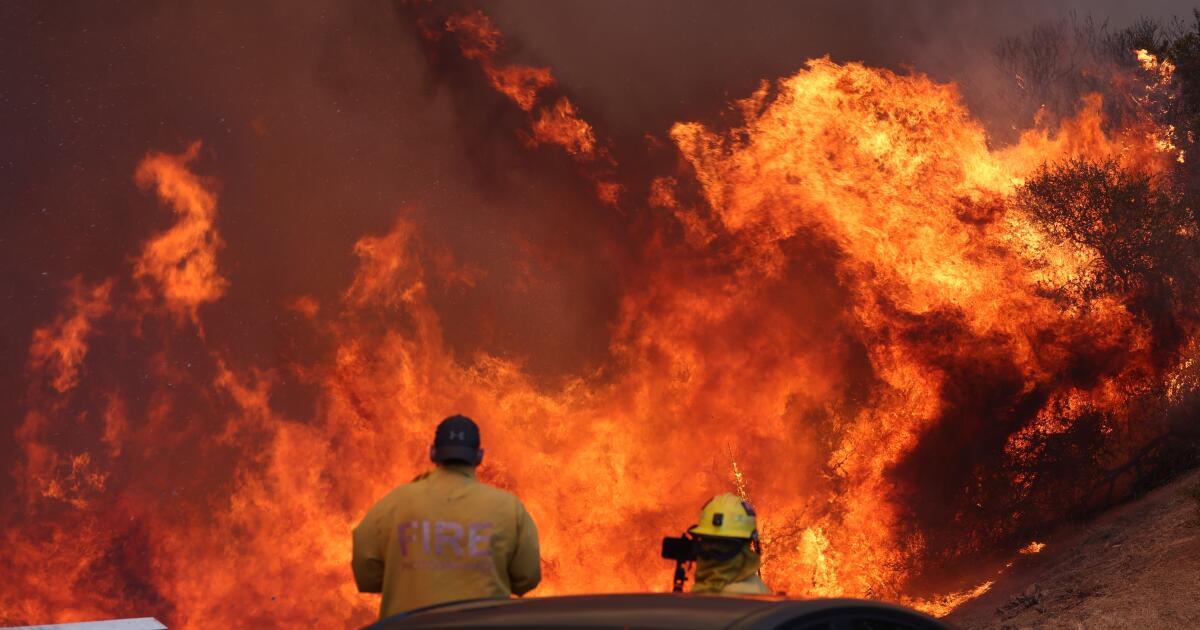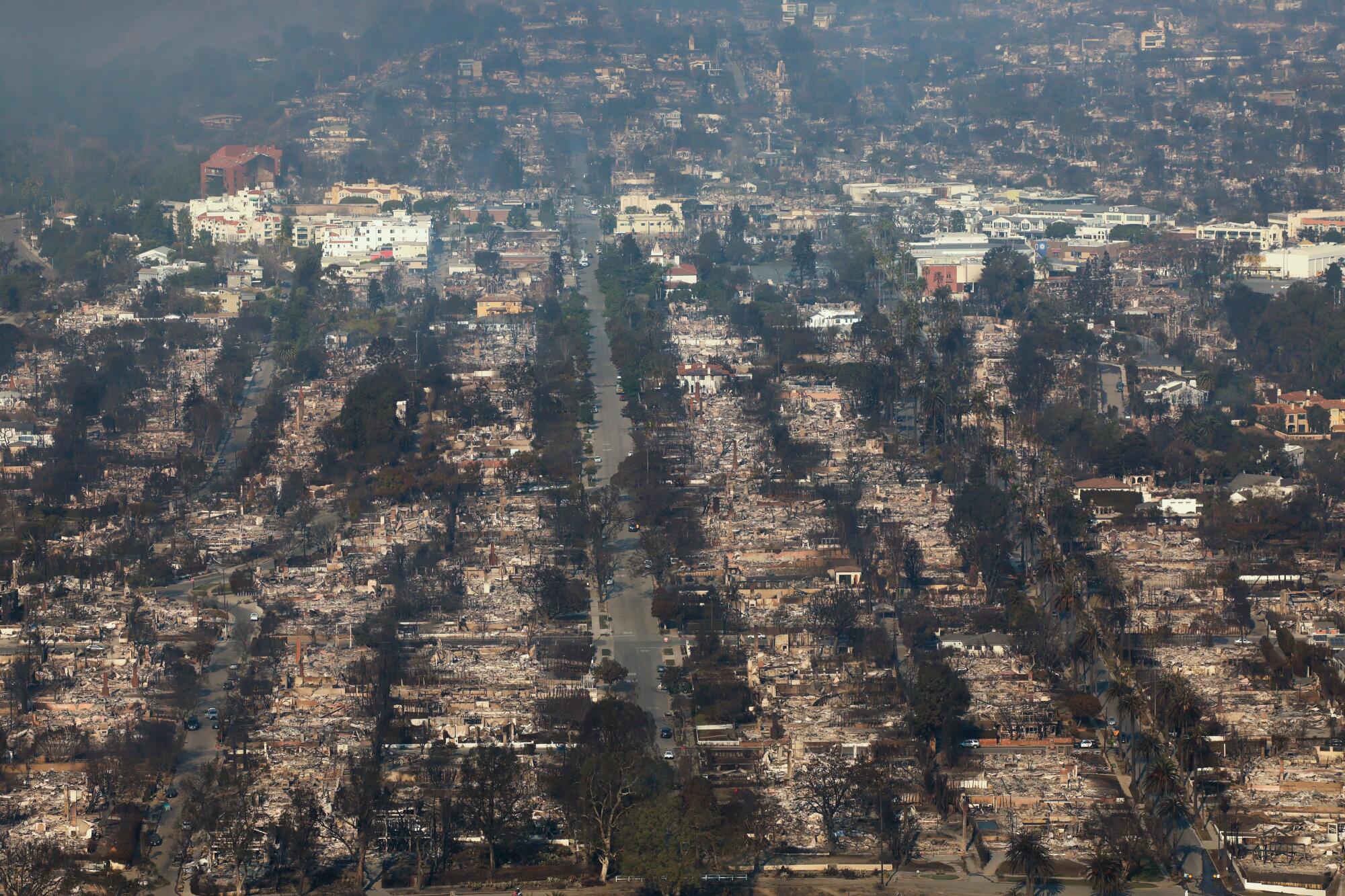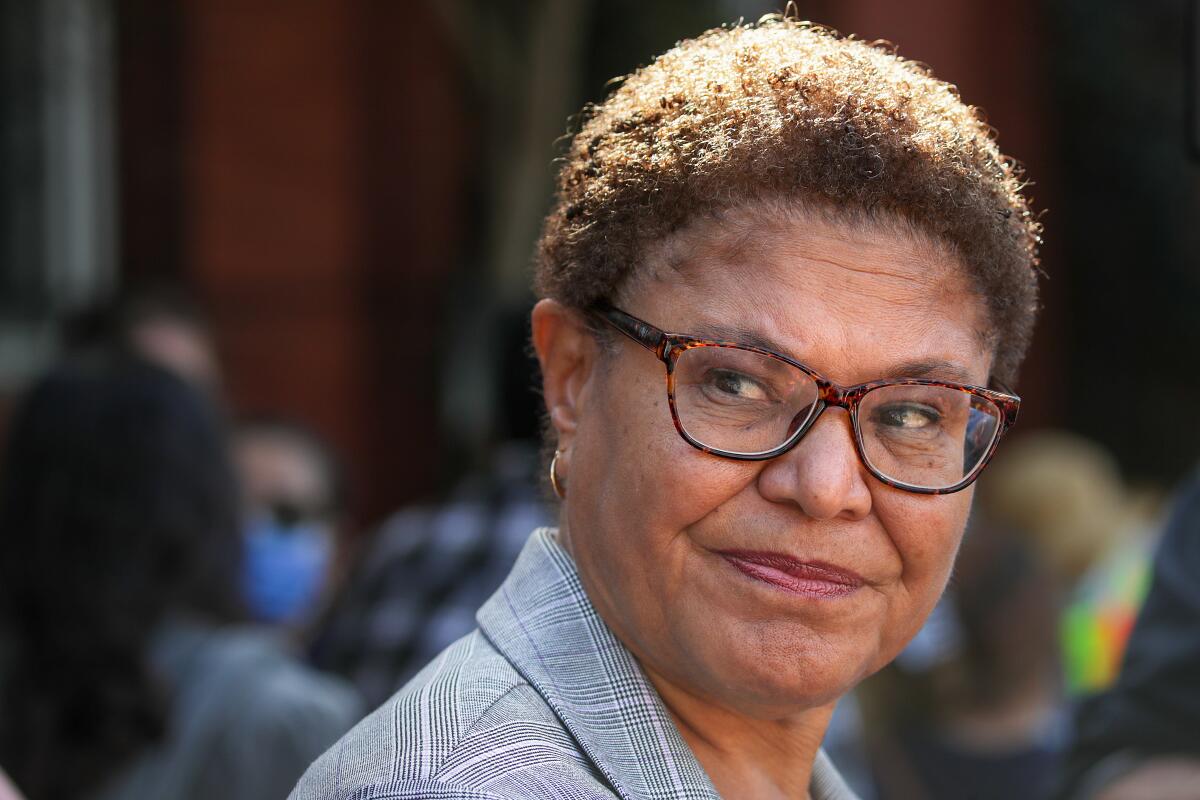LAFD report on Palisades fire was watered down in editing process, records show
For months after the Palisades fire, many who had lost their homes eagerly awaited the Los Angeles Fire Department’s after-action report, which was expected to provide a frank evaluation of the agency’s handling of the disaster.
A first draft was completed by August, possibly earlier.
And then the deletions and other changes began — behind closed doors — in what amounted to an effort to downplay the failures of city and LAFD leadership in preparing for and fighting the Jan. 7 fire, which killed 12 people and destroyed thousands of homes, records obtained by The Times show.
In one instance, LAFD officials removed language saying that the decision not to fully staff up and pre-deploy all available crews and engines ahead of the extreme wind forecast “did not align” with the department’s policy and procedures during red flag days.
Instead, the final report said that the number of engine companies rolled out ahead of the fire “went above and beyond the standard LAFD pre-deployment matrix.”
Another deleted passage in the report said that some crews waited more than an hour for an assignment the day of the fire. A section on “failures” was renamed “primary challenges,” and an item saying that crews and leaders had violated national guidelines on how to avoid firefighter deaths and injuries was scratched.
Other changes in the report, which was overseen by then-interim Fire Chief Ronnie Villanueva, seemed similarly intended to soften its impact and burnish the Fire Department’s image. Two drafts contain notes written in the margins, including a suggestion to replace the image on the cover page — which showed palm trees on fire against an orange sky — with a “positive” one, such as “firefighters on the frontline,” the note said. The final report’s cover displays the LAFD seal.
The Times obtained seven drafts of the report through the state Public Records Act. Only three of those drafts are marked with dates: Two versions are dated Aug. 25, and there is a draft from Oct. 6, two days before the LAFD released the final report to the public.
No names are attached to the edits. It is unclear if names were in the original documents and had been removed in the drafts given to The Times.
The deletions and revisions are likely to deepen concerns over the LAFD’s ability to acknowledge its mistakes before and during the blaze — and to avoid repeating them in the future. Already, Palisades fire victims have expressed outrage over unanswered questions and contradictory information about the LAFD’s preparations after the dangerous weather forecast, including how fire officials handled a smaller New Year’s Day blaze, called the Lachman fire, that rekindled into the massive Palisades fire six days later.
Some drafts described an on-duty LAFD captain calling Fire Station 23 in the Palisades on Jan. 7 to report that “the Lachman fire started up again,” indicating the captain’s belief that the Palisades fire was caused by a reignition of the earlier blaze.
The reference was deleted in one draft, then restored in the public version, which otherwise contains only a brief mention of the previous fire. Some have said that the after-action report’s failure to thoroughly examine the Lachman fire reignition was designed to shield LAFD leadership and Mayor Karen Bass’ administration from criticism and accountability.
Weeks after the report’s release, The Times reported that a battalion chief ordered firefighters to roll up their hoses and leave the burn area on Jan. 2, even though they had complained that the ground was still smoldering and rocks remained hot to the touch. Another battalion chief assigned to the LAFD’s risk management section knew about the complaints for months, but the department kept that information out of the after-action report.
After The Times report, Bass asked Villanueva to “thoroughly investigate” the LAFD’s missteps in putting out the Lachman fire, which federal authorities say was intentionally set.
“A full understanding of the Lachman fire response is essential to an accurate accounting of what occurred during the January wildfires,” Bass wrote.
Fire Chief Jaime Moore, who started in the job last month, has been tasked with commissioning the independent investigation that Bass requested.
The LAFD did not answer detailed questions from The Times about the altered drafts, including queries about why the material about the reignition was removed, then brought back. Villanueva did not respond to a request for comment.
A spokesperson for Bass said her office did not demand changes to the drafts and only asked the LAFD to confirm the accuracy of items such as how the weather and the department’s budget factored into the disaster.
“The report was written and edited by the Fire Department,” the spokesperson, Clara Karger, said in an email. “We did not red-line, review every page or review every draft of the report. We did not discuss the Lachman Fire because it was not part of the report.”
Genethia Hudley Hayes, president of the Board of Fire Commissioners, told The Times that she reviewed a paper copy of a “working document” about a week before the final report was made public. She said she raised concerns with Villanueva and the city attorney’s office over the possibility that “material findings” were or would be changed. She also said she consulted a private attorney about her “obligations” as a commissioner overseeing the LAFD’s operations, though that conversation “had nothing to do with the after-action” report.
Hudley Hayes said she noticed only small differences between the final report and the draft she reviewed. For example, she said, “mistakes” had been changed to “challenges,” and names of firefighters had been removed.
“I was completely OK with it,” she said. “All the things I read in the final report did not in any way obfuscate anything, as far as I’m concerned.”
She reiterated her position that an examination of missteps during the Lachman fire did not belong in the after-action report, a view not shared by former LAFD chief officers interviewed by The Times.
“The after-action report should have gone back all the way to Dec. 31,” said former LAFD Battalion Chief Rick Crawford, who retired from the agency last year and is now emergency and crisis management coordinator for the U.S. Capitol. “There are major gaps in this after-action report.”
Former LAFD Asst. Chief Patrick Butler, who is now chief of the Redondo Beach Fire Department, agreed that the Lachman fire should have been addressed in the report and said the deletions were “a deliberate effort to hide the truth and cover up the facts.”
He said the removal of the reference to the LAFD’s violations of the national Standard Firefighting Orders and Watchouts was a “serious issue” because they were “written in the blood” of firefighters killed in the line of duty. Without citing the national guidelines, the final report said that the Palisades fire’s extraordinary nature “occasionally caused officers and firefighters to think and operate beyond standard safety protocols.”
The final after-action report does not mention that a person called authorities to report seeing smoke in the area on Jan. 3. The LAFD has since provided conflicting information about how it responded to that call.
Villanueva told The Times in October that firefighters returned to the burn area and “cold-trailed” an additional time, meaning they used their hands to feel for heat and dug out hot spots. But records showed they cleared the call within 34 minutes.
Fire officials did not answer questions from The Times about the discrepancy. In an emailed statement this week, the LAFD said crews had used remote cameras, walked around the burn site and used a 20-foot extension ladder to access a fenced-off area but did not see any smoke or fire.
“After an extensive investigation, the incident was determined to be a false alarm,” the statement said.
The most significant changes in the various iterations of the after-action report involved the LAFD’s deployment decisions before the fire, as the wind warnings became increasingly dire.
In a series of reports earlier this year, The Times found that top LAFD officials decided not to staff dozens of available engines that could have been pre-deployed to the Palisades and other areas flagged as high risk, as it had done in the past.
One draft contained a passage in the “failures” section on what the LAFD could have done: “If the Department had adequately augmented all available resources as done in years past in preparation for the weather event, the Department would have been required to recall members for all available positions unfilled by voluntary overtime, which would have allowed for all remaining resources to be staffed and available for augmentation, pre-deployment, and pre-positioning.” The draft said the decision was an attempt to be “fiscally responsible” that went against the department’s policy and procedures.
That language was absent in the final report, which said that the LAFD “balanced fiscal responsibility with proper preparation for predicted weather and fire behavior by following the LAFD predeployment matrix.”
Even with the deletions, the published report delivered a harsh critique of the LAFD’s performance during the Palisades fire, pointing to a disorganized response, failures in communication and chiefs who didn’t understand their roles. The report found that top commanders lacked a fundamental knowledge of wildland firefighting tactics, including “basic suppression techniques.”
A paperwork error resulted in the use of only a third of the state-funded resources that were available for pre-positioning in high-risk areas, the report said. And when the fire broke out on the morning of Jan. 7, the initial dispatch called for only seven engine companies, when the weather conditions required 27.
There was confusion among firefighters over which radio channel to use. The report said that three L.A. County engines showed up within the first hour, requesting an assignment and receiving no reply. Four other LAFD engines waited 20 minutes without an assignment.
In the early afternoon, the staging area — where engines were checking in — was overrun by fire.
The report made 42 recommendations, ranging from establishing better communication channels to more training. In a television interview this month, Moore said the LAFD has adopted about three-quarters of them.























